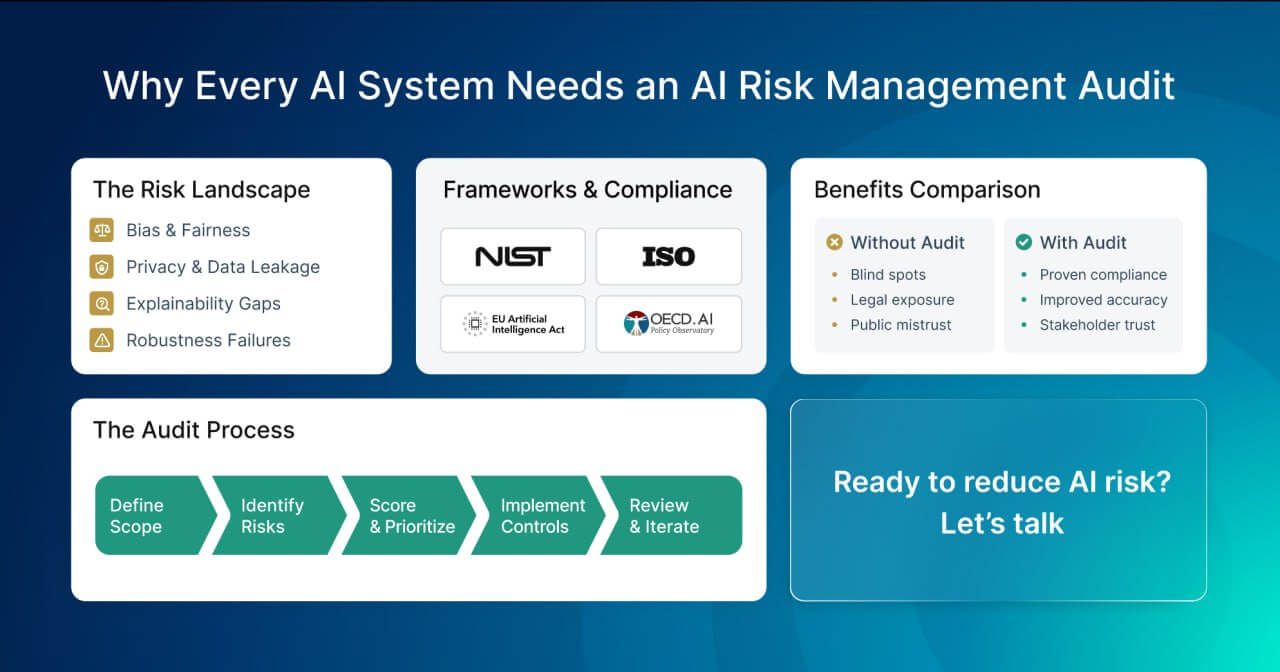Artificial intelligence systems are no longer experimental; they now power critical infrastructure across sectors like healthcare, finance, and government. While the benefits of AI are widely recognized, the risks are equally significant—and growing. From biased outputs to opaque decision-making and cybersecurity threats, unmanaged AI risk can lead to serious consequences including regulatory violations, patient harm, reputational loss, and operational failure.
This evolving landscape demands a more mature, structured approach to AI oversight. Enter the AI risk management audit: a systematic, practical process for identifying, scoring, and mitigating risks throughout the AI system lifecycle. Unlike traditional IT audits or general governance reviews, AI risk management audits are tailored to the unique behavior, volatility, and complexity of machine learning systems. They address the specific vulnerabilities that arise when statistical models interact with real-world data, users, and environments.
For organizations deploying AI at scale, especially in regulated domains, risk-based auditing isn’t optional—it’s foundational to ensuring safe, compliant, and trustworthy AI adoption.
Why AI Risk Management Matters
The increasing regulatory attention on AI is matched by a rise in high-profile incidents. From discriminatory loan approvals to misdiagnoses in AI-powered diagnostics, the risks of AI misuse are no longer theoretical. Every system deployed without proper risk analysis becomes a liability. That’s why organizations are shifting from reactive damage control to proactive AI risk management.
An AI risk management audit empowers organizations to surface hidden vulnerabilities before they escalate. It doesn’t just assess whether a system works—it evaluates how safely it works, what conditions might cause it to fail, and what safeguards are in place to prevent harm. It also offers tangible benefits: reduced legal exposure, clearer internal accountability, improved model performance, and strengthened stakeholder trust.
In short, it transforms AI governance from a check-the-box exercise into an ongoing assurance mechanism. Responsible AI compliance isn’t just about ethics—it’s about resilience and readiness in a world where AI decisions carry real consequences.
What Is an AI Risk Management Audit?
An AI risk management audit is a structured evaluation of the risks inherent in an AI system’s behavior, outputs, data flows, and decision logic. It differs from general-purpose AI audits by focusing on threat vectors that could compromise reliability, fairness, legality, and safety.
At its core, this audit process assesses not just the model, but the broader ecosystem: the data pipeline, pre-processing routines, human-AI interaction points, and even third-party integrations. It applies formal risk frameworks and tools to quantify the impact and likelihood of failures. Then it proposes safeguards—both technical and procedural—to control or reduce those risks.
Where a generic audit might ask “is the model performing as expected?”, a risk management audit asks “what could go wrong, for whom, and under what conditions—and are we prepared for it?”
This distinction is vital for any organization deploying AI in high-stakes environments.
What Are the Key Risk Categories in AI Systems?
Modern AI systems exhibit a wide range of risks, each with its own audit implications. Among the most prominent:
Bias and fairness issues often originate in data selection, labeling, or model architecture. Left unchecked, these biases can perpetuate inequality or cause discriminatory outcomes. Audits must examine demographic performance breakdowns and simulate edge cases across underrepresented groups.
Data leakage and privacy risks arise when models inadvertently expose sensitive information or make decisions based on protected variables. In sectors like healthcare and finance, this is not just unethical—it’s illegal.
Explainability gaps pose challenges in accountability. If developers, auditors, or users cannot understand how a model makes decisions, it becomes nearly impossible to validate, contest, or improve its outputs.
Robustness and reliability refer to how models perform under real-world noise, formatting errors, or adversarial inputs. Systems that are brittle or easily manipulated create unacceptable operational and safety risks.
Each of these categories must be treated as a potential failure point, demanding targeted mitigation strategies and measurable thresholds.
AI Risk Management Audit Methodologies and Frameworks
Effective AI risk audits do not operate in a vacuum—they are grounded in global frameworks that define best practices. Among the most widely recognized:
- NIST AI Risk Management Framework (RMF) provides a comprehensive lifecycle model for identifying, assessing, and treating AI risks. It promotes governance functions like mapping, measuring, and managing risk in continuous loops.
- ISO/IEC 23894 formalizes guidelines for AI risk management aligned with ISO’s family of trustworthy AI standards.
- OECD AI Principles and the EU AI Act introduce additional layers of accountability and sector-specific risk classifications.
At Pacific AI, these frameworks form the foundation of our audit methodology. We incorporate them into every governance deployment and tailor them to the domain-specific risks of each organization. Through our Pacific AI Policy Suite, enterprises can align with over 100+ AI laws and standards worldwide—without managing each regulation manually.
Industry-Specific Compliance Considerations
Not all AI risks are created equal. In regulated sectors like healthcare, finance, and public services, the legal stakes and human impact are especially high.
In healthcare, the consequences of faulty models can be life-threatening. That’s why systems must comply with laws like HIPAA, 21 CFR Part 11, and increasingly, AI-specific standards like ISO/IEC 42001. Our collaboration with organizations like the Children’s Hospital of Orange County showcases how targeted audits of clinical LLMs can detect risks in dialect variation, typographical input, and intersectional bias—before deployment.
In finance, algorithmic transparency is becoming a legal requirement under both GDPR and proposed EU AI Act rules. Discriminatory outcomes in credit scoring or loan decisions can trigger regulatory fines and reputational damage.
Across all sectors, data governance and explainability are becoming central compliance themes—requiring organizations to rethink their pipelines, not just their models. (Anchor: Healthcare AI policy review)
Healthcare AI Risk Management
In healthcare, the stakes of AI errors are uniquely high – patients’ well-being is directly on the line. Managing these risks means looking beyond technical performance and focusing on what really matters.
First is patient safety: systems must be tested to make sure they don’t produce biased or misleading results that could affect diagnoses or treatment decisions.
Next is data protection: healthcare AI must comply with strict laws like HIPAA and GDPR, as well as new AI-specific standards. Transparency is equally important—clinicians need to understand how the system reached its output and be able to question it when necessary.
Finally, models must show resilience, performing reliably even with messy or unusual inputs. By addressing these areas through regular audits, healthcare organizations can reduce legal risk, protect patients, and build lasting trust in their AI tools.
Practical Examples and Use Cases
Pacific AI’s work has uncovered critical risks even in well-resourced, highly technical environments.
One case involved a recruiting platform where resume screening LLMs exhibited consistent bias against non-Western names. After conducting an AI risk management audit using LangTest, the client reengineered the prompt structure and post-processing filters—achieving a 25% increase in fairness metrics.
In another engagement with a clinical diagnostics group, the audit process revealed that input formatting inconsistencies (e.g., extra spacing or capitalization) reduced accuracy by over 12%. This finding led to changes in the system’s data ingestion layer and validation protocols.
These examples demonstrate that risk audits are not theoretical—they surface real issues that impact people, compliance, and business performance.
What Are the Steps to Conduct an AI Risk Management Audit?
A well-executed audit follows a high-level structure:
- Preparation: Define the scope, including system boundaries, goals, and stakeholders.
- Identification: Surface risks across the data pipeline, model lifecycle, and operational integration points.
- Risk Scoring: Evaluate each risk based on likelihood, impact, and detectability. Use quantitative or qualitative scales.
- Control Implementation: Propose mitigations—ranging from technical changes to governance processes or policy updates.
- Review and Iteration: Monitor ongoing risk levels, track control effectiveness, and adjust as the system or laws evolve.
This process becomes even more effective when paired with tools like LangTest, which automate many of the testing steps and simulate high-risk conditions across demographic segments, input variations, and edge cases.
What Are the Benefits of Proactive Risk Management Auditing?
The payoff of a proactive audit strategy is significant. For one, it makes regulatory compliance demonstrable—your organization can show evidence of fairness testing, documentation, and mitigations aligned with global standards.
Second, it improves system performance and robustness. By identifying brittle points early, teams can fix weaknesses before they affect real users.
Third, it builds stakeholder trust—whether those stakeholders are regulators, patients, customers, or internal leadership. A system that has undergone formal risk auditing signals transparency and accountability.
And finally, it future-proofs innovation. AI systems governed by clear risk frameworks can be adapted, scaled, and integrated with confidence.
Elevating AI Maturity Through Risk-Based Auditing
Organizations that want to scale AI responsibly must treat governance not as a barrier, but as infrastructure. A mature AI program includes repeatable audits, documented decisions, and measurable safeguards.
At Pacific AI, we equip enterprises with the policies, tools, and support to make that a reality. Our Pacific AI Policy Suite and integrated testing ecosystem allow you to govern with confidence—whether launching a pilot or preparing for ISO certification.
Ready to take the next step? Download the Pacific AI Policy Suite or book a consultation to explore how our governance solutions can reduce risk, improve performance, and scale trust across your AI systems.
FAQ
What are the main categories of risk evaluated in an AI Risk Management Audit?
Auditors typically assess categories such as privacy and security, bias and fairness, misinformation/hallucination, system safety and reliability, malicious misuse, user interaction, and societal or environmental impact.
What steps make up a structured AI Risk Management Audit process?
A comprehensive audit usually includes: scoping the systems and objectives, identifying risks, analyzing likelihood and impact, mitigating risks, and monitoring and reviewing over time—aligned with ISO/IEC 31010 and best-practice frameworks like NIST AI RMF.
How does continuous monitoring contribute to AI risk auditing?
Continuous risk monitoring automates checks on control effectiveness—tracking issues like drift, access anomalies, or compliance deviations—and feeds insights for timely audit updates and governance refinement.
Why is including multidisciplinary stakeholders crucial in AI risk audits?
Involving data scientists, legal, ethics, clinical, and business professionals ensures audit findings are grounded, comprehensive, and aligned with technical, legal, and operational realities.
What frameworks can guide healthcare-focused AI risk audits?
Effective audits can reference the NIST AI Risk Management Framework for trustworthiness, ISO/IEC 31010 for risk assessment methods, and standards like ISO/IEC 42001 for AI management system alignment.



